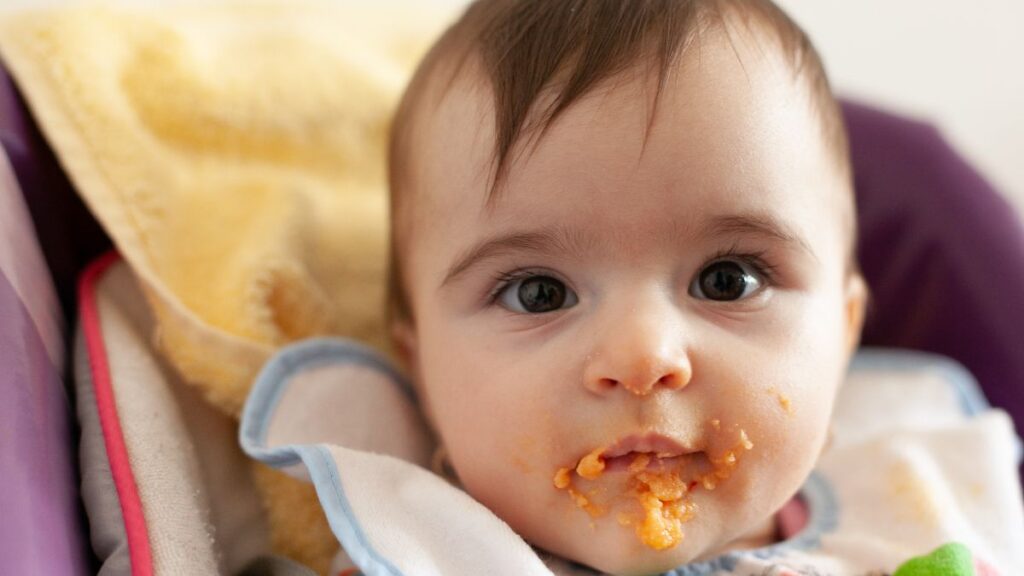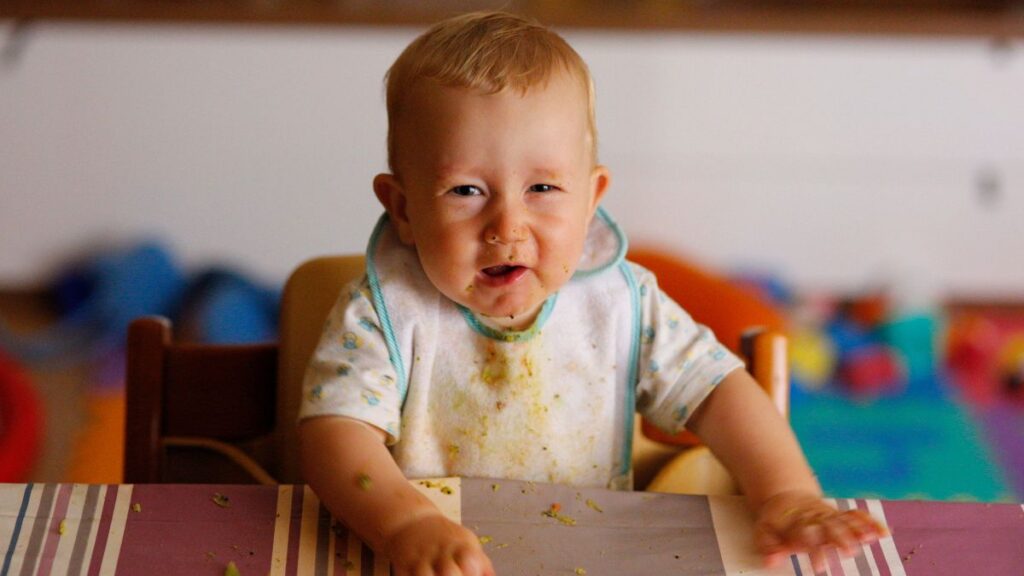Introduction: Understanding Baby Food Allergy Rash
Baby food allergy rash those spoonfuls of mashed banana or yogurt often lead to something far less cheerful– an unexpected rash that blossoms across an infant’s fragile skin. Seeing mad red bumps or hives spread on your little one can send out a wave of panic through even the calmest parent. Is it an allergy?

The reality is, infant food allergic reaction rashes are relatively common, and many are not lethal. Still, they should never be dismissed. A rash can be the body’s way of signaling that it’s battling with a particular food. Comprehending why these rashes happen, how to find the difference between moderate inflammation and something more severe, and what actions to take later can empower you as a moms or dad. When your child needs you most, understanding does not just alleviate anxiety– it equips you to act rapidly and confidently.
Why Rashes Happen After Baby Eats
The Immune System’s Overreaction Explained
At the heart of most food allergic reactions lies the immune system. In infants, the immune system is still discovering what’s safe and what’s not. When it wrongly determines a harmless protein– like the ones in milk, eggs, or peanuts– as a risk, it springs into defense mode. This triggers a cascade of chain reactions, most notably the release of histamines.
Histamines are mighty messengers. They dilate blood vessels, increase blood flow, and cause swelling– all in an effort to “eradicate” the intruder. On the surface, this appears like hives, bumps, or spots. To us, it looks like a rash. To the child’s immune system, it’s doing its job too strongly.
Difference Between Food Allergies and Food Sensitivities
Not every response is a full-blown allergic reaction. It’s essential to distinguish between sensitivities or intolerances.
- Food allergic reactions involve the body’s immune system. They can trigger rashes, swelling, vomiting, and even lethal anaphylaxis.
- Food level of sensitivities (like lactose intolerance) typically affect food digestion. They may cause gas, bloating, or diarrhea, but do not cause rashes.
This difference matters. While sensitivities can be unpleasant, allergic reactions require cautious management and medical attention.
Common Foods That Trigger Baby Food Allergy Rash
Dairy and the Trouble With Cow’s Milk Proteins
Cow’s milk is one of the most typical allergens in babies. Proteins like casein and whey can stimulate immune responses, leading to red rashes around the mouth or across the body. For breastfed infants, even dairy consumed by the mother can pass through breastmilk and cause responses.
Egg Whites and Yolks: A Sneaky Culprit
Eggs are another frequent culprit. The proteins in egg whites are particularly allergenic, though yolks can cause responses too. Reactions typically look like blotchy patches on the skin within minutes or hours of eating.
Nuts, Seeds, and Hidden Traces in Packaged Foods
Even trace amounts of peanuts, tree nuts, or sesame seeds can activate extreme reactions in delicate babies. Parents need to be extra alert with packaged foods, where cross-contamination prevails.
Soy, Wheat, and Other Common Allergens
Soy proteins hide in formulas, processed snacks, and sauces, while wheat gluten can be discovered in cereals or breads. Both can trigger scratchy rashes, hives, or worsening eczema in allergy-prone infants.
Identifying the Signs of a Baby Food Allergy Rash
Redness, Bumps, and Hives: What to Look For
A baby’s food allergic reaction rash frequently resembles raised bumps or clusters of hives– small, itchy welts that might appear like mosquito bites. Sometimes, it’s merely flat, red spots that spread out throughout the cheeks, chin, or upper body.
When Rashes Spread Beyond the Face
While numerous rashes start around the mouth where food makes contact, severe reactions can spread quickly across the body. If the rash is widespread or appears together with swelling, that’s a red flag.
The Length Of Time After Eating, Do Rashes Appear?
Many allergy-related rashes appear within two hours of consuming the trigger food. Sometimes, they’re instant; other times, they may take longer. If a rash appears days later, it’s less likely to be an allergy and more likely to be irritation, eczema, or another condition.
Other Symptoms That May Accompany the Rash
Digestive Clues Like Gas, Diarrhea, or Vomiting
A rash paired with gastrointestinal upset strengthens the case for a food allergic reaction. Explosive diarrhea, consistent throwing up, or unusual gas can be your baby’s method of saying “something isn’t right.”

Respiratory Symptoms Parents Should Watch
Coughing, wheezing, nasal congestion, or trouble breathing alongside a rash can suggest a more serious allergic reaction. These require immediate medical assessment.
Habit Changes Linked to Food Allergies
Babies can’t tell us in words when they feel unhealthy; however, their behavior speaks volumes. Extreme weeping, irritability, eating rejection, or difficulty sleeping after meals may indicate an allergic response.
First Aid for a Baby’s Food Allergy Rash
Gentle Skincare That Soothes Irritated Skin
Things initially: keep your child comfy. Wash the skin carefully with lukewarm water and pat it dry. Apply a fragrance-free, hypoallergenic moisturizer to lock in hydration and lower inflammation.
Natural Remedies That May Provide Relief
Some parents discover relief in natural options like oatmeal baths, which relax itching, or coconut oil, which softens inflamed skin. While these treatments can help moderate cases, they should not replace professional advice.
When to Use Over-the-Counter Treatments
For moderate pain, pediatricians may recommend infant-safe antihistamines or moderate hydrocortisone creams. These should constantly be used under medical guidance, never as a DIY repair.
When to Call the Pediatrician Immediately
Recognizing Signs of a Severe Allergic Reaction
If the rash appears with swelling of the lips, tongue, or throat, or if your child has difficulty breathing, it might be anaphylaxis. This is a life-threatening emergency that requires instant healthcare.
The Red Flags Parents Should Never Ignore
Other caution signs include relentless throwing up, lethargy, rash spread, or refusal to feed. Trust your impulses– if something feels wrong, call the medical professional.
Checking and Diagnosis of Food Allergies in Babies
Skin Prick Tests and How They Work
This test injects tiny quantities of common allergens into the child’s skin. If the skin responds with a little bump or inflammation, it might suggest an allergic reaction.
Blood Tests for Allergic Reactions
Blood tests determine IgE antibodies, which the immune system produces in response to allergies. They’re less immediate than skin tests but can offer helpful information.
Removal Diets and Food Challenges
Typically, the most telling approach is merely removing believed foods and slowly reestablishing them under medical supervision. This helps confirm the culprit with minimal risk.
Tips for Preventing Baby Food Allergy Rash
Introducing One New Food at a Time
Offer each new food a three-day trial period. This makes it easier to trace any response back to its source.
Keeping a Food and Symptom Diary
Logging what your infant eats and any resulting signs produces a valuable record for you and your pediatrician.
Turning Foods to Reduce Exposure
A varied diet can decrease the danger of repeated allergen exposure and ensure balanced nutrition.
Safe Alternatives for Common Triggers
Non-Dairy Options Babies Can Tolerate
Oat milk, coconut yogurt, or hypoallergenic solutions can be fantastic alternatives for children sensitive to cow’s milk.
Plant-Based Proteins That Replace Eggs and Meat
Pureed chickpeas, lentils, and beans pack protein without the danger of egg or meat allergic reactions.
Gluten-Free Grains for Sensitive Stomachs
Rice, quinoa, millet, and buckwheat are gentle on food digestion and offer vital nutrients.
Practical Feeding Tips for Everyday Life
Checking out Labels Like a Pro Parent
Navigating the child aisle can feel like deciphering a foreign language. Labels overflow with promises; however, the fine print often holds the truth.
Moms and dads attuned to safety understand that watchfulness avoids discomfort and potential threats. Spotting irritants early is crucial– common perpetrators like dairy, soy, wheat, and nuts can activate responses such as a baby food allergy rash. Acknowledging these terms keeps little tummies safe and calm, even in their less apparent types.

Beyond irritants, search for transparency. The fewer components, the better. Whole fruits, veggies, and grains must take center stage, not unpronounceable fillers. Labels that highlight “no added sugar” or “organic” can be practical, but context matters– constantly check out beyond the bold claims.
Mastering label literacy transforms grocery shopping into an empowering act of care. Each notified choice suggests fewer surprises, healthier meals, and higher comfort. By decoding the details, parents nourish with intent and construct a strong structure of trust between food, security, and their growing child.
Preparing Allergy-Safe Meals in the House
Developing meals for kids with various sensitivities needs both attentiveness and creativity. The cooking area becomes more than a cooking location- it becomes a safe house where every active ingredient matters. Careful preparation makes sure that what nourishes likewise safeguards.
The very first step is awareness. Comprehending which foods might provoke reactions, such as a child’s food allergic reaction rash, assists in guiding wish lists and meal plans. Reading labels meticulously, preventing cross-contamination, and picking fresh, single-ingredient fruit and vegetables form the structure of allergy-safe cooking.
Replacement plays a decisive role. Dairy options like oat or almond milk, gluten-free grains like quinoa or rice, and plant-based proteins can be effortlessly integrated without compromising nutrition. Herbs, spices, and natural tastes add vibrancy, making meals appealing without counting on irritants.
Preparation must remain basic yet intentional. Steam, roast, or mash foods in ways that protect their natural stability while ensuring digestibility. Store leftovers in separate containers to prevent accidental blending.
With a thoughtful technique, allergy-safe meals can be both excellent and nourishing. Each spoonful becomes a reassurance, enabling children to explore flavors without fear. Families find convenience and self-confidence at the table in this balance of safety and taste.
Handling Dining Out or Family Gatherings
Shared meals often develop treasured memories, yet for households managing food sensitivities, they can also trigger concern. Eating in restaurants or going to a dynamic household gathering requires insight, not fear. Preparation is the key to mixing security with satisfaction.
Clear explanations decrease the opportunity of hidden active ingredients leading to problems like an infant food allergy rash. Bringing a safe dish from home ensures your kid has something worry-free and nourishing on their plate.
Observation matters as much. Watch out for part sizes, food swaps, and well-meaning family members eager to share deals with. Even trace amounts of an irritant can activate pain, making watchfulness an act of love.
Developing a safe bubble within the event enables your little one to feel included without compromise. Snacks loaded in advance, wipes for fast clean-ups, and a readiness plan in case of reaction offer reassurance.
Minutes of connection must outweigh moments of tension. With mindful preparation, households can accept togetherness, savor tradition, and secure health. Pleasure at the table feels fuller when both hearts and bellies are at ease.
Assisting Your Baby Build Tolerance Over Time
The Role of Early Exposure in Allergy Prevention
Introducing varied foods throughout infancy is more than a culinary turning point– it may shape long-lasting health. Research recommends that carefully timed direct exposure to potential irritants can assist the immune system in adjusting, reducing the possibility of extreme sensitivities later in life. Instead of protecting children entirely, steady and conscious intro becomes an effective tool.
Peanuts, eggs, dairy, and wheat are among the foods frequently associated with youth allergic reactions. Moms and dads should remain alert for responses such as a baby food allergy rash, hives, or modifications in breathing, reacting quickly if symptoms occur.
Texture likewise contributes. Starting with purees and approaching thicker consistencies develops not simply variety but self-confidence in trying new tastes. This journey has to do with balance– welcoming exposure while keeping safety.
Early exposure is not an assurance but a hopeful action towards durability. By introducing foods thoughtfully, families can nurture tolerance, broaden taste buds, and foster a much healthier relationship with consuming from the start. In this careful balance lies both security and possibility.
How Pediatricians May Recommend Reintroduction
The path forward typically consists of a mindful reintroduction stage for households with food allergies. Pediatricians assist this procedure precisely, guaranteeing that each step is rooted in security and science. Instead of preventing irritants forever, many experts advocate for gradual exposure under regulated conditions.
The procedure generally begins with a waiting duration, allowing signs such as a child’s food allergy rash or digestive upset to decrease completely. When stability is restored, a pediatrician may recommend offering minuscule portions of the allergenic food, frequently in your home but sometimes in a clinical setting for extra peace of mind. The objective is to observe tolerance, not to overwhelm.

Consistency and observation end up being critical. Parents are often encouraged to keep comprehensive notes on timing, part size, and reactions, whether subtle skin modifications, fussiness, or intestinal discomfort. Each observation provides essential insight into the progress of the care strategy.
The overarching function is to broaden dietary flexibility and decrease worry around common foods. With careful assistance, this process can open doors to a more diverse, nourishing menu while keeping safety at the forefront.
Dealing with Emotional Stress as a Parent
Alleviating Anxiety About Mealtime Reactions
It’s natural to feel distressed; however, preparation is your finest ally. When rashes appear, understanding what to see helps you stay calm.
Discovering Support in Allergy Parent Communities
Parenting a kid with food sensitivities can sometimes feel isolating, but connection changes everything. Allergic reaction parent communities– whether online groups, regional meetups, or assistance circles– provide more than recommendations. They produce a space where shared experiences relieve concern and inspire self-confidence.
Stories of navigating reactions, such as handling an unexpected infant food allergy rash, resonate deeply because they originate from those who truly comprehend. These conversations often provide helpful suggestions– safe dish swaps, trusted brand names, or methods for school lunches– that exceed what medical guides alone can offer.
The emotional assistance is similarly practical. No concern feels too small in these communities, and no worry is dismissed. When difficulties emerge and peace of mind is restored, when progress is made, moms and dads discover encouragement. What starts as info sharing often evolves into genuine relationships developed on empathy and solidarity.
By taking advantage of collective knowledge, families discover they are not alone. Community support becomes a lifeline, blending compassion with practical know-how. Together, moms and dads construct strength, finding comfort and nerve in understanding others, and they stroll the same course towards safe, nourishing meals and carefree moments at the table.
Developing a Baby-Friendly Allergy Action Plan
Actions to Take During a Mild Reaction
File what was eaten, relieve the rash, and monitor for escalation. A calm, methodical reaction helps keep the circumstance under control.
Emergency Preparedness for Severe Cases
If recommended) On hand, keep antihistamines or an epinephrine auto-injector. Share the action plan with all caretakers, from grandparents to daycare personnel.
Myths and Misconceptions About Baby Food Allergy Rash
Unmasking the They’ll Outgrow It Quickly Belief
While many kids outgrow milk, egg, or soy allergic reactions, peanut and shellfish allergic reactions typically continue. Never presume time alone will solve the issue.
Why Natural or Organic Foods Aren’t Always Safe
Organic or healthy foods may be devoid of pesticides, but allergens remain. A peanut is still a peanut, despite how it was grown.
Specialist Tips From Pediatric Allergists
Balancing Nutrition While Managing Allergies
Removing foods should not imply eliminating nutrients. Pediatric allergists assist in designing diet plans abundant in calcium, iron, and protein without irritants.
Motivating Variety Without Risk
Even with restrictions, range is possible. Safe fruits, veggies, grains, and proteins keep meals interesting and nourishing.
Long-Term Outlook for Babies With Food Allergies
Possibilities of Outgrowing Certain Allergies
Data are encouraging: many children grow out of egg, milk, and soy allergic reactions by school age. Peanuts and shellfish are more workable; however, they are persistent.
Supporting a Healthy Relationship With Food
Children must mature, seeing food as something to take pleasure in, not fear. Encouragement, variety, and safe expedition build favorable practices.
Frequently Asked Questions From Parents
- Can Teething Cause a Rash That Mimics an Allergy?
Yes. Drool-related inflammation throughout teething often triggers red spots around the mouth that simulate food allergic reaction rashes.
- How Do I Tell the Difference Between Eczema and Allergy Rash?
Eczema tends to be chronic, dry, and scaly, while allergic reaction rashes appear suddenly after direct food exposure and typically fade within days or hours.
- Should I Delay Introducing Allergenic Foods?
Delaying the introduction may increase the danger of developing allergic reactions. Current standards motivate controlled early exposure.
Conclusion: Staying Calm, Informed, and Prepared
A baby food allergy rash may look worrying, but it’s also a chance to understand your child’s unique requirements better. With cautious observation, the best medical guidance, and a proactive technique, you can keep your little one safe while nurturing their relationship with food.

Child food allergy rashes are pretty typical, and most are not life-threatening. Spotting irritants early is important– typical perpetrators like dairy, soy, wheat, and nuts can set off responses such as a baby food allergy rash. Understanding which foods might provoke responses like an infant’s food allergy rash assists in guiding shopping lists and meal plans. Parents should stay alert for reactions such as a child’s food allergic reaction, rash, hives, or changes in breathing, responding swiftly if signs occur.
A baby food allergy rash may look alarming, but it’s also an opportunity to understand your child’s unique requirements better.
<script type="application/ld+json">
{
"@context": "https://schema.org",
"@type": "BlogPosting",
"mainEntityOfPage": {
"@type": "WebPage",
"@id": "https://pinmebaby.com/baby-food-allergy-rash-tips-for-worried-parents-2025/"
},
"headline": "Proven Baby Food Allergy Rash Tips for Worried Parents 2025",
"description": "Baby food allergy rash those spoonfuls of mashed banana or yogurt often lead to something far less cheerful– an unexpected rash that blossoms across an infant’s fragile skin. Seeing mad red bumps or hives spread on your little one can send out a wave of panic through even the calmest parent. Is it an allergy?",
"image": "https://pinmebaby.com/wp-content/uploads/2025/09/baby-food-allergy-rash-6.jpg",
"author": {
"@type": "Person",
"name": "Shokhina Begum",
"url": "https://pinmebaby.com/about-us/"
},
"publisher": {
"@type": "Organization",
"name": "Shokhina Begum",
"logo": {
"@type": "ImageObject",
"url": "https://pinmebaby.com/wp-content/uploads/2025/09/cropped-pinmebaby.jpg"
}
},
"datePublished": "2025-09-13",
"dateModified": "2025-09-13"
}
</script>

62c5xs